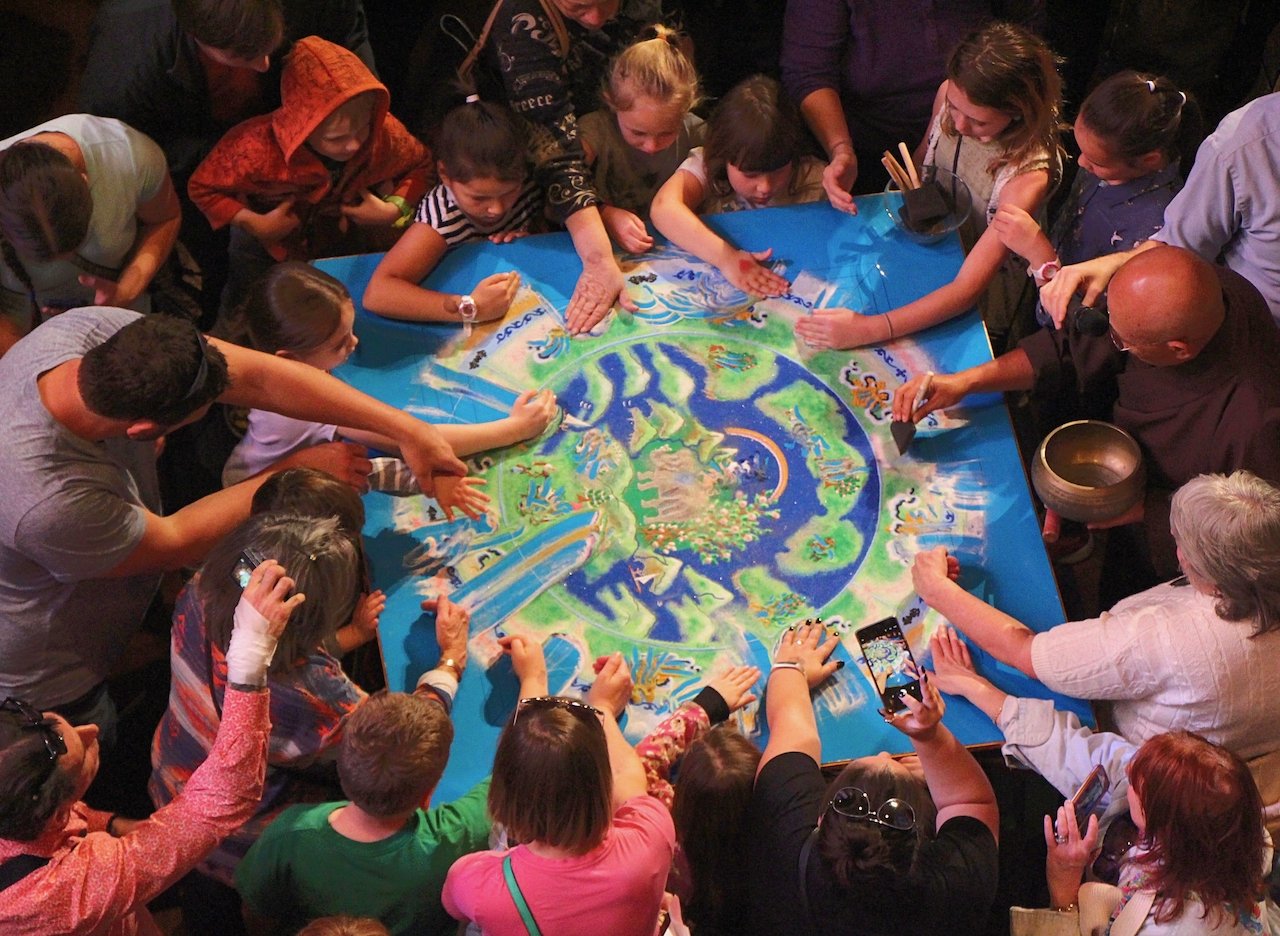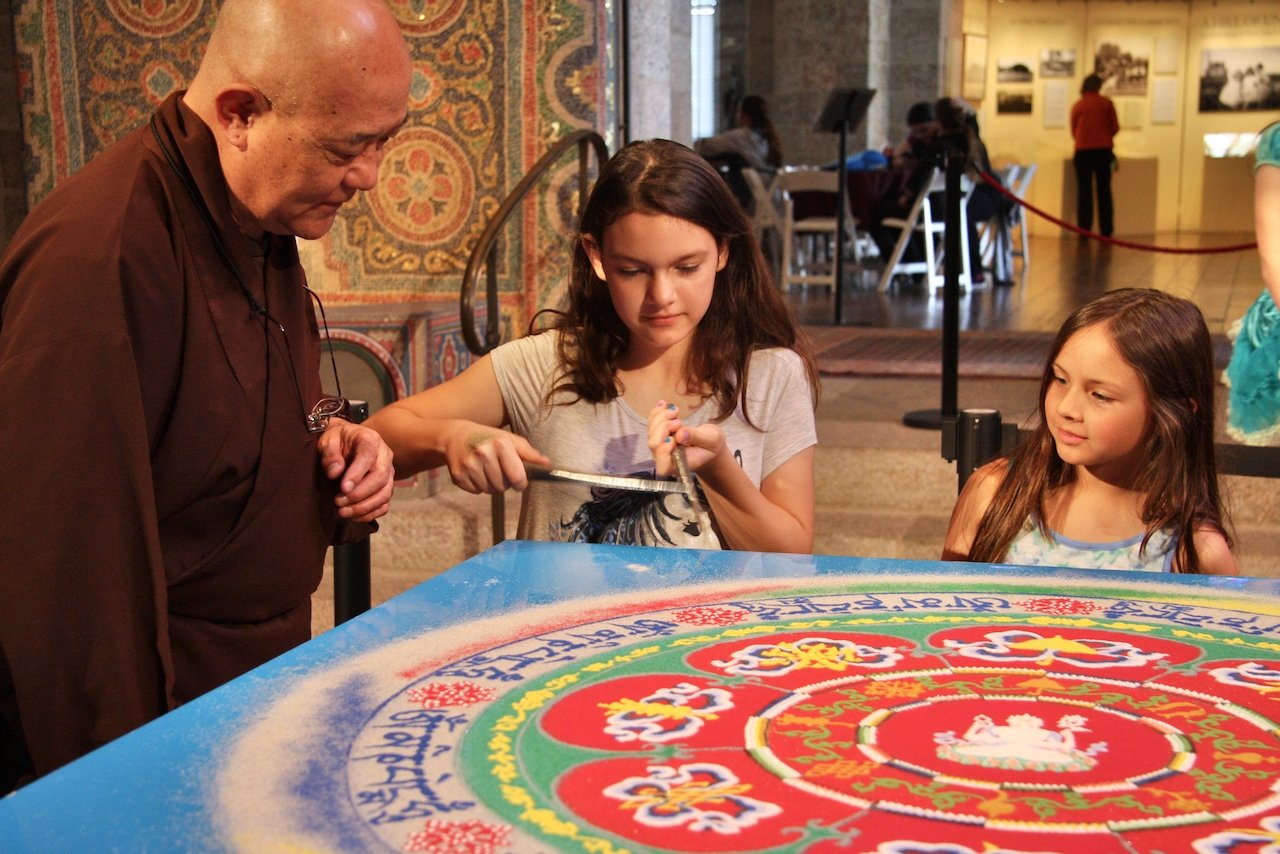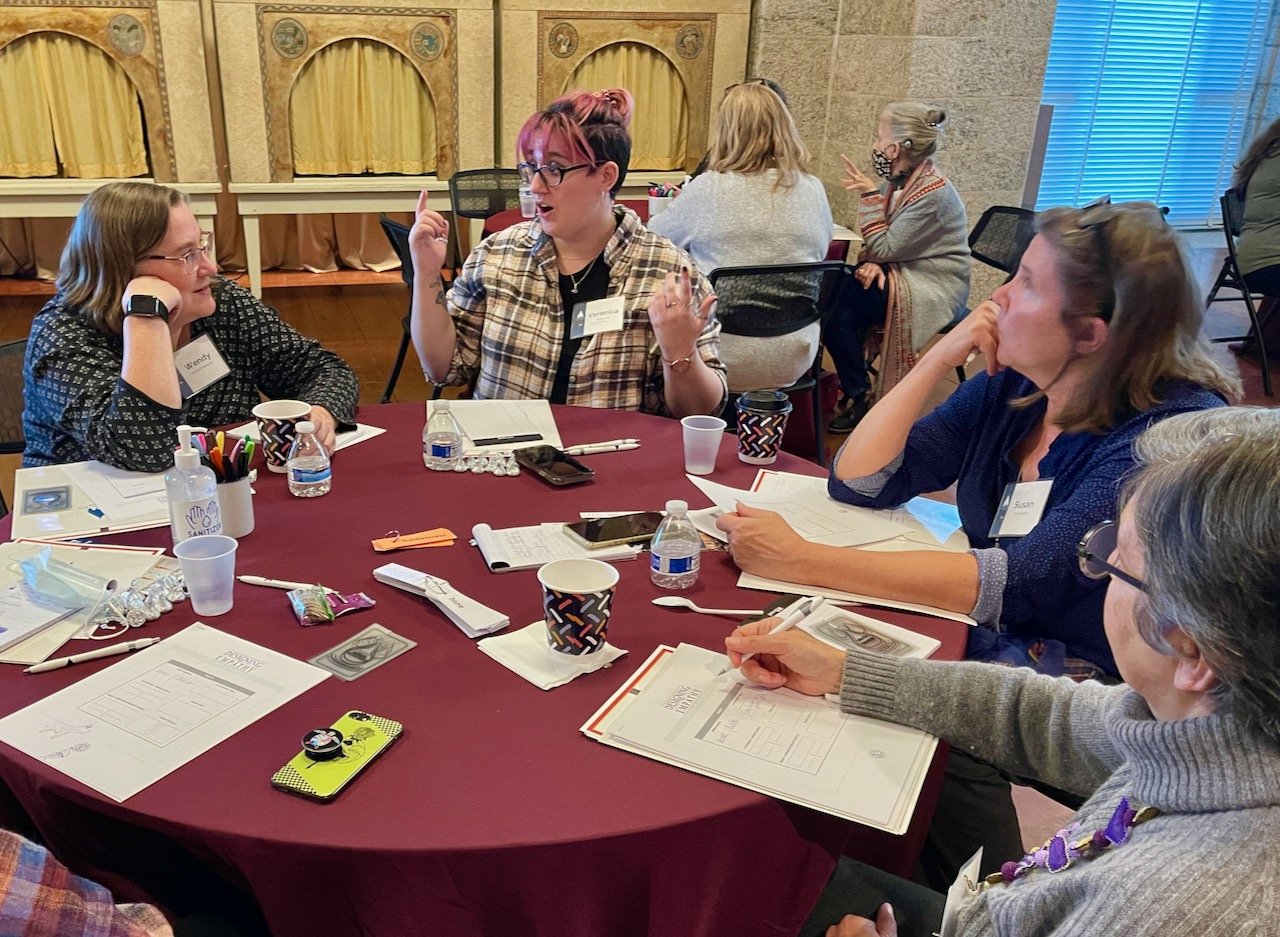Glencairn Museum News | Number 2, 2022
The Venerable Lama Losang Samten and Museum visitors with a Tibetan sand mandala he created in Glencairn’s Great Hall in April, 2018. According to Samten, “After completion of the mandala at Glencairn we always have a dismantling ceremony. . . The dismantling includes everything, the designs and colors. The ceremony starts with me, and then I like people to participate in pushing the sand into the middle of the table to mix all of the colors together” (“Tibetan Sand Mandala at Glencairn Museum: An Interview with the Venerable Lama Losang Samten,” Glencairn Museum News, Number 4, 2014).
Figure 1: In 2017, Glencairn Museum and The Pennsylvania German Cultural Heritage Center at Kutztown University collaborated on an exhibition titled, Powwowing in Pennsylvania: Healing Rituals of the Dutch Country. Powwow (or Braucherei in the language of the Pennsylvania Dutch), a tradition of ritual healing that has sometimes been misunderstood and inaccurately portrayed, includes a diverse array of Christian rituals used to heal the body and protect against physical and spiritual harm. In 2019, the two museums collaborated on another exhibition titled, Hex Signs: Sacred and Celestial Symbolism in Pennsylvania Dutch Barn Stars.
Over the past several decades, museum professionals across the United States and abroad have been engaged in exploring ways to make their museums more accessible to their visitors by becoming less “object-centered” and more “human-centered.” At Glencairn Museum we are developing an interpretive approach that includes the goal of fostering empathy—a term that is sometimes defined as “walking in someone else’s shoes.” According to Jordan S. Potash, editor-in-chief of Art Therapy: Journal of the American Art Therapy Association,
“Museums have the potential to serve as communal gathering places in which visitors encounter new perspectives, challenge preconceived notions, and develop personal connections to social issues. Implied in these ideas is that viewers must be able to understand another’s circumstances, appreciate their emotional state, and perhaps feel moved to take action. In other words, the bridge between viewer and subject is empathy” (“Response Art: Using Creative Activity to Deepen Exhibit Engagement,” in Fostering Empathy Through Museums, 2016, p. 77).
Glencairn Museum’s mission is to interpret art, artifacts, and other cultural expressions of faith as illustrations of religious beliefs and practices around the world and through time. There is a beautiful variety in the way that people from various cultures and faiths have answered the enduring spiritual questions that all humans share in our common endeavor to find meaning and purpose in our lives. While celebrating this diversity of religious expression, the Museum’s interpretive approach also aims to bring to light what unites all people as human beings. Our exhibitions, programs, and tours are designed to stimulate reflection, build understanding, and foster empathy by recognizing these universal spiritual concepts within diverse religious traditions.
According to Crispin Paine, the author of Religious Objects in Museums: Private Lives and Public Duties, “museums should make explicit the religious meaning of the objects in their care, both out of concern for the feelings of people to whom such objects are significant, and in order to help visitors understand them more fully” (2013, p. 78). By creating opportunities for Glencairn’s visitors to encounter religions that differ from their own, we hope they will go home with a deeper understanding and appreciation of them (see Figure 1). And because the Museum’s collection includes works of art from both ancient and modern religions, we hope that engaging with these objects will help our visitors “walk in the shoes of” religious practitioners past and present.
But how can museum educators help visitors cultivate empathetic feelings for the beliefs and practices of people who practiced their religion thousands of years ago? In an essay for the book, Religion in Museums: Global and Interdisciplinary Perspectives (2017), Ed Gyllenhaal, Glencairn Museum’s curator, suggests one possible approach:
“For example, ancient Egyptian beliefs and practices relating to the afterlife often appear mysterious and bizarre to museum visitors. An educator in a museum’s Egyptian gallery may therefore, intentionally or unintentionally, find himself or herself emphasizing the ‘otherness’ of Egyptian funerary religion while interpreting tomb reliefs and objects from burial chambers. However, in doing so the educator will have missed an opportunity to provide a space for the cultivation of empathetic feelings within the group toward the ‘other’ religion. What if, instead, the educator were to ask the group if they would be willing to share what they know and value about funerary prayers, rituals, and monuments from their own religious traditions? While in many instances these will differ greatly from ancient Egyptian beliefs and practices, there will also likely be similarities. Many funerary customs—past and present—meet the same human needs to grieve and to pay tribute to loved ones who have passed on” (“Religion at Glencairn Museum: Past, Present, and Future,” p. 242).
Figure 2: Throughout history, funerary customs have varied widely from one culture to another, but humans have always shared the same need to grieve for family and friends who have died. The Embalmer’s Art, a series of miniaturized dioramas in Glencairn's Egyptian gallery, presents the practice of mummification as a religious ritual, not just a physical process. The mummification ritual was intended to preserve and care for the deceased individual by transforming the corpse into an eternal home for their ka, or life-force.
In the case of contemporary religions, one of the best ways for museums to generate interfaith understanding is to provide visitors with opportunities to encounter actual religious practitioners from source communities. For example, nearly every year since 2010, as part of Glencairn’s annual Sacred Arts Festival, the Venerable Lama Losang Samten has been invited to create a Tibetan Buddhist sand mandala in Glencairn’s Great Hall. Samten also works with Museum staff to build a large altar near the sand mandala platform (Figure 3). The altar includes Buddhist objects from the Glencairn Museum collection alongside Samten’s own traditional implements such as offering bowls, incense, bells, beads, and textiles painted with the eight auspicious symbols of Tibetan Buddhism.
Figure 3: In 2014, the Venerable Lama Losang Samten worked with Museum staff to build this large altar near the sand mandala platform. His purpose was to show what Tibetan Buddhist altars look like, how they are used, and what the objects on altars represent. Each morning, before he worked on the mandala, he offered either water, coffee, or tea in the bowls on the altar.
In the early 1980s, Samten was a master of ritual dance and sand mandalas, and also the personal attendant to His Holiness the XIV Dalai Lama. In 1988, he was asked by the Dalai Lama to demonstrate the creation of a sand mandala for a Western audience—an unprecedented event that took place at the American Museum of Natural History in New York City. Since then, Samten has created sand mandalas at a variety of venues throughout the United States, including many museums. In a 2014 interview with Glencairn Museum News, Samten said,
“When I first came to the United States in 1988, of course, the sand mandala I displayed was my main purpose. But personally, in my heart, another reason for coming was my desire to truly learn more about Christianity and Judaism. The more I learn, the more I see similarities, and this is such a wonderful thing. . . We tend to have a problem if we don’t really know another religion well, if we only know it superficially, and miss the true message of that religion” (Glencairn Museum News, Number 4, 2014, Tibetan Sand Mandala at Glencairn Museum: An Interview with the Venerable Lama Losang Samten).
Figure 4: The Venerable Lama Losang Samten shows two young Glencairn Museum visitors how to pour colored sand on a Tibetan sand mandala using a tool called the chakpur (2016).
In June, 2016, Elif Gökçiğdem, Ph.D., a historian of Islamic art, traveled to Glencairn to spend a day with the Museum staff exchanging ideas about empathy-building in museums. In recent years, Gökçiğdem has become a thought leader in the area of empathy and its role in informal learning platforms (museums, zoos, and similar institutions). She has edited two groundbreaking books on the subject: Fostering Empathy Through Museums (Rowman and Littlefield, 2016; see Figure 5) and Designing for Empathy: Perspectives on the Museum Experience (American Alliance of Museums & Rowman and Littlefield, 2019; see Figure 6).
Figure 5: Fostering Empathy through Museums, edited by Elif Gökçiğdem (2016).
Figure 6: Designing for Empathy: Perspectives on the Museum Experience, edited by Elif Gökçiğdem (2019).
In November, 2019, Christine McDonald, who at the time was head of education and program development at Glencairn, attended a “Designing for Empathy Summit” in Washington, D.C., on behalf of the Museum. Led by Elif Gökçiğdem, the summit brought together museum professionals, artists, and scientists in order to share the latest research and evidence-based approaches to empathy-building. In April, 2021, Glencairn hosted its own virtual “Designing for Empathy” workshop on the theme, “Concept to Action: What is Empathy & What Does It Look Like in a Museum?”; Gökçiğdem was the keynote speaker, and Glencairn Museum Director Brian Henderson served as host and discussion moderator. One of the presenters, Zorana Ivcevic, Ph.D., a senior research scientist at the Yale Center for Emotional Intelligence, addressed the workshop’s theme from a scientific perspective. She studies the role of emotion and emotional intelligence in creativity and well-being, as well as how to use the arts to promote emotion and creativity skills. According to Ivcevic,
“Schools should not be the only places for learning. . . Because museumgoers are not explicitly evaluated on their behavior and thinking, they are likely to feel freer to engage their curiosity, making museums well positioned to stimulate the exploration of different perspectives that is key for developing empathy” (Zorana Ivcevic and Fundación Botín, introduction, Designing for Empathy: Perspectives on the Museum Experience, 2019, p. 2).
In October, 2021, Glencairn Museum co-sponsored a virtual “Designing for Empathy Summit & Workshop” alongside The Children’s Museum of Pittsburgh, The George Washington University Museum, The Museum of Us, The Seattle Aquarium, and several other institutions. Brian Henderson participated in a panel discussion about how empathy manifests itself in our world, and how cultural institutions can help cultivate it. The following year, in March, 2022, Glencairn hosted an in-person workshop led by Elif Gökçiğdem (Figures 7-8). Using objects from the Glencairn Museum collection, “Designing for Empathy II” encouraged participants to develop empathy-building skills through group discussions, prototyping exercises, and facilitator feedback. The workshop explored the theme, “Othering, Belonging, and Becoming One.” (A short video, available on YouTube, has been made about this Glencairn workshop.) According to Gökçiğdem,
“In a time when our world is facing complex social and environmental problems, exploring our capacity to hold empathy and love for each other is more essential than ever. Taking action beyond divisiveness and fragmentation towards healing and unity, is a choice—a choice that requires empathy: our ability to imagine another’s feelings, emotions, and perspective. Empathy can be a portal for love, and the best way to learn it, is through experience.”
Figure 7: Elif Gökçiğdem talks to “Designing for Empathy II” workshop participants in Glencairn’s chapel about how to use her Designing for Empathy framework to expand and deepen an audience’s engagement with an object and its story. The object she used as an example is a 14th-century Persian ceramic tile in the Glencairn Museum collection depicting the simurgh, a beneficent bird known from Persian mythology and literature.
Figure 8: Participants in Glencairn’s “Designing for Empathy II” workshop discuss what they have learned from creating their own empathy-building program based on an object of their choice in the Glencairn Museum collection.
Certainly empathy, as both a concept and a practice, is something that is vital, not only for museums, but for any organization that exists for the purpose of improving people’s lives. Workshop participant Nina Dewees, who works for Bryn Athyn Church (a New Church congregation, i.e. Swedenborgian-Christian), shared her thoughts with us about her experience at Glencairn’s workshop this past March:
“I was deeply moved and inspired by the “Designing for Empathy II” workshop and Elif Gökçiğdem’s compassionate leadership. In my role for Bryn Athyn Church as Support and Engagement Coordinator, it is essential that I show up daily with empathy. I need to appreciate and understand where people are coming from—feeling and acknowledging their hopes, needs, values and experience. Elif sensitively arranged and shepherded the workshop activities, which built on each other to gradually develop trust among the participants, and led to many personal and professional insights. Sincere thanks to Glencairn Museum and Elif, for creating this opportunity for such profound learning and personal expansion.”
How can we design interpretations at Glencairn that encourage our visitors to explore the perspectives and feelings of the people who created the magnificent works of art they encounter throughout the building? We will continue to explore new theoretical models and interpretive methods for the purpose of creating exhibitions, tours, and programs that—we sincerely hope—will help build understanding and cultivate empathy.
(CEG)
A complete archive of past issues of Glencairn Museum News is available online here.









